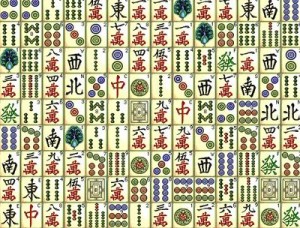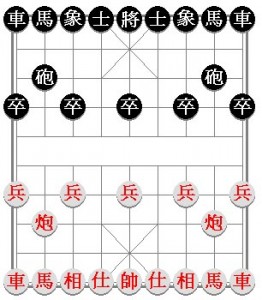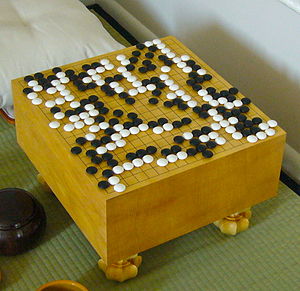Chinese Games Posted by sasha on Sep 10, 2012 in Culture, Uncategorized
While strolling the streets of any Chinese city, it’s not uncommon to find crowds of people huddled around a table, watching the action unfold intently. You find yourself wondering, “What exactly are they so focused on?” Becoming yourself, you slowly creep up to take a peek, even though you’re just a tiny bit worried that your 老外 status will make you stand out like a sore thumb. Surprisingly, no one so much as bats an eye at you, as they are simply that caught up in the goings on in front of them. When you finally get close enough to see what all the fuss is about, you find a couple of Chinese guys sucking down cigarettes while they play an intense board or card game. Games are all the rage in China, and this type of street-side action is a huge part of Chinese culture. In order to help you better understand what’s going on, today I’m going to introduce some of China’s most popular games:
Mahjong (麻将 – má jiàng)
This is without a doubt the most popular game in China. You’ll find people playing it in the street and in parks, and you’ll even find plenty of mahjong parlors. It’s played with four people, and is a game of strategy with a little bit of chance. One myth about mahjong suggests that the Great Sage himself, Confucius, developed this game way back around 500 BC.
A couple of 外国人 try their hand at this classic Chinese game.
A mahjong set usually includes 144 tiles, split into three categories: suits, honors, and bonuses. To begin with, each player makes a stack of 36 tiles, and these stacks are all put together to form a square wall. From there, each player is dealt 12 tiles, and they pick up one more to form a hand of 13. The goal of the game is to make melds with your tiles. The game goes around, with each player drawing a new tile and discarding one face up, which the others may use to try to make a meld.
Here are the different melds that you can make:
- pung (碰 – pèng) – a set of three identical tiles
- kong (杠 – gāng) – a set of four identical tiles
- chow(吃 – chī) – three suited tiles in sequence
A hand is won when a player gets a mahjong hand – three melds plus a pair. There are many different ways to score mahjong, and they vary from region to region.
A basic introduction to the set-up and rules of mahjong.
Chinese Chess (象棋 – xiàng qí)
This strategy game for two is also incredibly popular in China, and you’ll often find hordes of cab drivers gathered together to play during their downtime. While the Chinese name literally translates as “elephant game,” it actually represents a battle between two armies, with the goal being to capture your opponent’s general. It’s played on a board that is nine lines wide and ten lines long – vertical lines are called files while horizontal are called ranks. Just like Western chess, players move their pieces to try and capture those of their opponent. When a player has the potential to capture his enemy’s general on the next move, it’s known as “delivering a check” (照将 – zhào jiāng). Of course, if your opponent can do nothing to stop his demise, it’s known as “checkmate” (将死 – jiàng sǐ).
Watch this energetic guy teach you the rules of xiangqi.
Go (圍棋 – wéi qí)
This famous board game has a history going back over 4,000 years, and as such there are plenty of myths surrounding its beginnings. Similar to xiangqi, it is played on a board between two players. Way back in the day, weiqi was known as the game of scholars, while xiangqi was the game of the masses. An official board is 19×19 lines, but smaller boards of 13×13 and 9×9 are also used for beginners. Players use stones (one uses white and other black) to try and occupy the most territory on the board. As stones can be captured and removed, they are also counted in the score. One important rule is the “ko rule” (劫 – jié), which says that a player cannot make a move that returns the game to its previous position. The game is popular all around the world, as this relatively simple game is incredibly rich in strategy. More detailed rules can be found here.
This super ’90s video is actually still quite good, and you can watch it on YouTube instead of a VCR now!
Next time you see a huge crowd of Chinese guys gathered around a group, go up and take a closer look to see if you can figure out how the game works. Better yet, strike up a conversation, or ask them to teach you! You’ll be surprised to find how welcoming and friendly people can be, and they’ll be especially excited to help a foreigner who is interested in their traditional games.

Build vocabulary, practice pronunciation, and more with Transparent Language Online. Available anytime, anywhere, on any device.
About the Author: sasha
Sasha is an English teacher, writer, photographer, and videographer from the great state of Michigan. Upon graduating from Michigan State University, he moved to China and spent 5+ years living, working, studying, and traveling there. He also studied Indonesian Language & Culture in Bali for a year. He and his wife run the travel blog Grateful Gypsies, and they're currently trying the digital nomad lifestyle across Latin America.









Comments:
tiyuhui:
快乐才一点都不难!